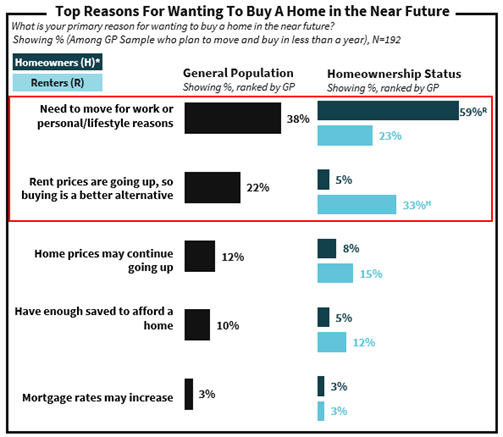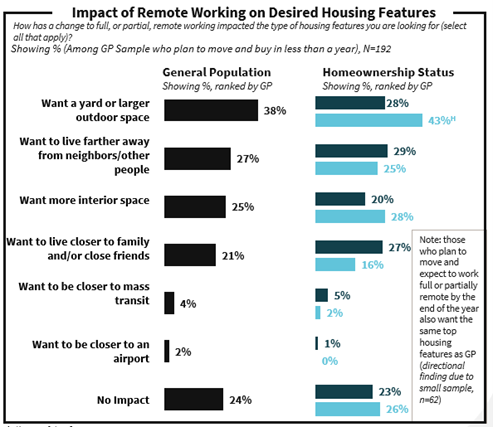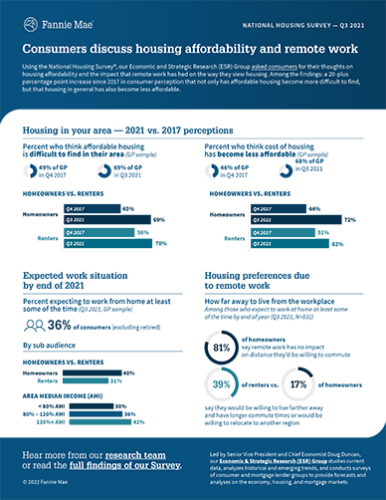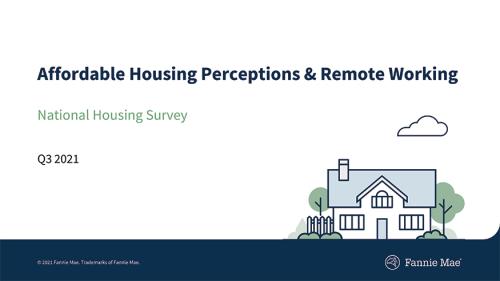Consumers Discuss Affordability and the Impact of Remote Work on Housing Preferences
Amid record-high home and rent price growth, as well as shifting consumer preferences due to the pandemic, housing affordability and availability remain top of mind for many. As part of Fannie Mae’s Q3 2021 National Housing Survey®, we asked homeowners and renters for their thoughts on housing affordability and the impact that remote work has had on the way they view housing. We last surveyed consumers on many of these same questions in 2017, and this latest survey offered interesting insights into how the pandemic has influenced perceptions and preferences.
Our survey results revealed a stunning (but not necessarily surprising) 20-plus percentage point increase in consumer perception that not only has affordable housing become more difficult to find, but housing in general has also become less affordable.
Affordability a Growing Concern
Interestingly, most survey respondents think their own current housing is affordable, a belief that has not changed since 2017. However, in 2021, we saw a dramatic increase in the percentage of consumers who felt that housing in their area had become both less affordable and more difficult to find. In 2017, 45% of homeowners said affordable housing in their area was difficult to find, a number that ballooned to 69% in 2021.
We believe this perception could be a factor behind some of the ongoing inventory constraints. If residents feel that their current housing costs are affordable in an otherwise unaffordable area, then they may opt against looking to move. While this can be true for either homeowners or renters, in our view homeowners probably feel this pressure a bit more acutely, since a stable, affordable mortgage payment would likely disincentivize many from selling and having to go through the purchase process again.
Additionally, an overwhelming 92% of mortgage holders felt that their current home was at least somewhat affordable. If, as we suspect, this perception does disincentivize people from listing their homes, then it has constrained the supply of homes for sale and made it even more difficult for potential first-time homebuyers to take advantage of low mortgage rates and escape record-high rent increases. We currently estimate that rent prices increased 10% in 2021 alone, and we currently expect rent prices to increase between 4.0% and 5.0% in 2022. It shouldn’t be surprising then that rent growth was the primary reason renters expressed interest in buying a home in the near future.
Indeed, the desire for homeownership among this many renters is a trend worth monitoring, as it may strengthen already-high purchase demand – even as supply remains limited in many parts of the country and recent interest rate increases further constrain affordability.
How Remote Working and Commuting Impact Housing Preferences
We also asked consumers what their remote working conditions would be by the end of 2021, and how it impacted their housing and commuting preferences. More than one-third of respondents expected to work from home at least some of the time, while nearly half indicated that they would need to physically go to their workplace every day. Digging deeper, a higher percentage of homeowners than renters said they could work remotely (40% of homeowners vs. 31% of renters). Additionally, a larger percentage of higher-income respondents said they expected to have some type of remote work situation.
When we asked respondents whether their remote work arrangements would impact their willingness to live farther away, thereby potentially creating longer commute times, significantly more renters than homeowners responded that they would be willing to do that. In fact, a quarter of renters with some form of remote work arrangement would be willing to live further away from the office, and an additional 13% would be willing to completely relocate to another region. We suspect remote-working renters are more willing to move than homeowners because the physical act of moving is typically easier: They can move at the end of their lease, while homeowners would need to sell their house – typically a much longer and far more complicated process. The data also showed that remote-working, lower-income respondents are more willing to commute longer distances than other higher-income respondents, most likely because they can find less expensive housing farther away from job centers.
Reasons for Moving and Buying
We also asked a smaller segment of the population – consumers who plan to move and buy a home in the next year – why they were moving. A majority of current homeowners said they planned to move due to work or personal/lifestyle reasons, whereas the top reason cited by renters was rising rent prices, as noted above.
These potential near-term buyers were also asked if remote working had any impact on their desired home features. Unsurprisingly, given the changing work paradigm, as well as behavioral shifts likely stemming from the pandemic, 38% of all respondents said they wanted more outdoor/yard space, while 27% said they wanted to live farther away from neighbors. Renters, in particular, wanted more outdoor space, while current homeowners said living closer to family and friends was a priority.
Interestingly, being closer to mass transit or an airport were cited as the least desired features, suggesting that consumers may not plan to do much commuting or traveling on a regular basis, at least in the near future. Lastly, almost 25% of survey respondents were indifferent about the issue entirely, stating that remote working would have no impact on any of their desired housing features.
Ongoing Demand for All Types of More Affordable Housing
Clearly, consumers have become much more aware of the lack of housing affordability, and continued remote work flexibility is likely giving many the ability to live farther away in more affordable areas. Consumers who want to purchase in the next year indicate that work/personal lifestyle – or rent prices going up, for those renting – are their main reasons for moving, and many indicated that they want more outdoor space and privacy. To us, these insights suggest that if more homes or rental properties became available in slightly less dense areas, it would likely be welcome relief for many households. But with single-family housing prices expected to increase by 7.6% in 2022, as measured by the FHFA Purchase-Only Index, after rising an astonishing 17.6% in 2021, both current and potential homeowners may continue to have difficulty purchasing a home.
To learn more, read the research deck or access our infographic.
The authors thank Steve Deggendorf, Mark Palim, and Matt Classick for valuable contributions in the creation of this commentary and the design of the research. Of course, all errors and omissions remain the responsibility of the authors.
The 2021 National Housing Survey is weighted to the 2019 American Community Survey (1-year estimates). Weighting is used to account for known biases resulting from non-response, and to compensate for unexpected divergences from the American Community Survey estimates and historical results from the National Housing Survey. Research results are based on the National Housing Survey general population summary statistics and do not control for consumers with similar borrowing or renting characteristics. Please see the National Housing Survey’s Technical Notes file for more information on data controls and weighting.
Opinions, analyses, estimates, forecasts, and other views of Fannie Mae's Economic & Strategic Research (ESR) Group or survey respondents included in these materials should not be construed as indicating Fannie Mae's business prospects or expected results, are based on a number of assumptions, and are subject to change without notice. How this information affects Fannie Mae will depend on many factors. Although the ESR Group bases its opinions, analyses, estimates, forecasts, and other views on information it considers reliable, it does not guarantee that the information provided in these materials is accurate, current, or suitable for any particular purpose. Changes in the assumptions or the information underlying these views could produce materially different results. The analyses, opinions, estimates, forecasts, and other views published by the ESR Group or survey respondents represent the views of that group as of the date indicated and do not necessarily represent the views of Fannie Mae or its management.






